This is a list of national birds arranged alphabetically by name of birds.These birds are officially designated.
Chukar-National Bird Of Pakistan
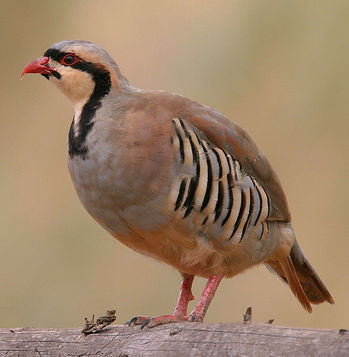
The Chukar (Alectoris chukar) is a Eurasian upland gamebird in the pheasant family Phasianidae of the order Galliformes, gallinaceous birds. Other common names of this bird include 'Chukker' (Sometimes misspelled as 'Chuker'), 'Chukar Partridge', 'Red-legged Partridge', 'Rock Partridge', 'Indian Hill Partridge', 'Chukka', 'Chukkar', 'Chukor', 'Chukore', 'Chikone', 'Kabk', 'Kau-Kau', and 'Keklik'. The Chukar is the National Bird of Pakistan.
This partridge has its native range in Asia from Pakistan and Kashmir, and Afghanistan in the east to southeastern Europe in the west, and is closely related and similar to its western equivalent, the Red-legged Partridge, Alectoris rufa. It has been introduced widely, and became established in the United States, Canada, New Zealand and Hawaii. In Great Britain, hybrids between this species and the also introduced Red-legged Partridge are common.
This partridge has its native range in Asia from Pakistan and Kashmir, and Afghanistan in the east to southeastern Europe in the west, and is closely related and similar to its western equivalent, the Red-legged Partridge, Alectoris rufa. It has been introduced widely, and became established in the United States, Canada, New Zealand and Hawaii. In Great Britain, hybrids between this species and the also introduced Red-legged Partridge are common.
African Fish Eagle-National Bird Of Zimbabwe and Zambia
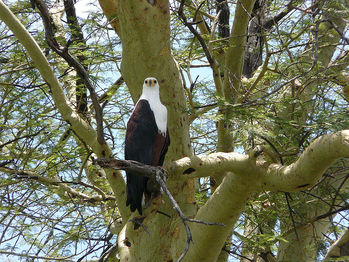
The African Fish Eagle (Haliaeetus vocifer) to distinguish it from the true fish eagles (Ichthyophaga), the African Sea Eagle is a large species of eagle. It is the national bird of Zimbabwe and Zambia.
Its closest relative appears to be the critically endangered Madagascar Fish-eagle (H. vociferoides). Like all sea-eagle species pairs, this one consists of a white-headed species (The African Fish Eagle) and a tan-headed one. These are an ancient lineage of sea-eagles, and as such have dark talons, beaks, and eyes (Wink et al. 1996). Both species have at least partially white tails even as juveniles.
The African Fish Eagle is a large bird, and the female, at 3.2-3.6 kg (7-8 lbs) is larger than the male, at 2-2.5 kg (4.4-5.5 lbs). Males usually have a wingspan of about 2 m (6 feet), while females have wingspans of 2.4 m (8 feet). The length is 63–75 cm (25–30 in). They are very distinctive in appearance with a mostly brown body and large, powerful, black wings. The head, breast, and tail of African Fish Eagles are snow white and the hook-shaped beak is mostly yellow with a black tip.
This species is still quite common near freshwater lakes, reservoirs, or rivers, although they can sometimes be found near the coast at the mouths of rivers or lagoons. As their name implies, African Fish Eagles are indigenous to Africa, ranging over most of continental Africa south of the southern-most edge of the Sahara Desert.
Its closest relative appears to be the critically endangered Madagascar Fish-eagle (H. vociferoides). Like all sea-eagle species pairs, this one consists of a white-headed species (The African Fish Eagle) and a tan-headed one. These are an ancient lineage of sea-eagles, and as such have dark talons, beaks, and eyes (Wink et al. 1996). Both species have at least partially white tails even as juveniles.
The African Fish Eagle is a large bird, and the female, at 3.2-3.6 kg (7-8 lbs) is larger than the male, at 2-2.5 kg (4.4-5.5 lbs). Males usually have a wingspan of about 2 m (6 feet), while females have wingspans of 2.4 m (8 feet). The length is 63–75 cm (25–30 in). They are very distinctive in appearance with a mostly brown body and large, powerful, black wings. The head, breast, and tail of African Fish Eagles are snow white and the hook-shaped beak is mostly yellow with a black tip.
This species is still quite common near freshwater lakes, reservoirs, or rivers, although they can sometimes be found near the coast at the mouths of rivers or lagoons. As their name implies, African Fish Eagles are indigenous to Africa, ranging over most of continental Africa south of the southern-most edge of the Sahara Desert.
Bald Eagle-National Bird Of United States of America
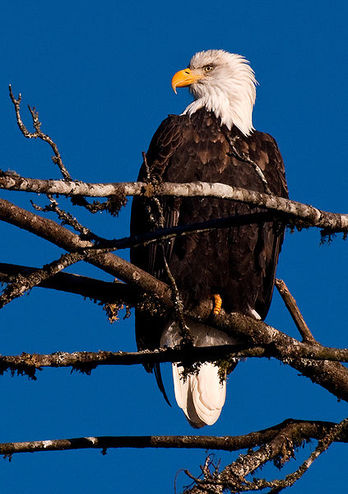
The Bald Eagle (Latin name: Haliaeetus leucocephalus) is a bird of prey that lives in North America. It is the national bird of the United States of America. The Bald Eagle is a kind of sea eagle (It is sometimes called by this name). It can be found in most of Canada, all of the United States, and the northern part of Mexico. It lives near big areas of water where there is a lot of food to eat and old trees to nest in. It is called bald because of the white head and neck, making it look bald.
The species almost died out in the United States (While their numbers were growing in Alaska and Canada) late in the 20th century, but now has a more stable population.
The Bald Eagle is a large bird. It is usually as tall as 70–102 centimeters (28–40 in) and its wingspans are 2.44 m (96 in). Female eagles are about 25 percent larger than males.Adult females weigh 5.8 kilograms (13 lb), while males weigh 4.1 kilograms (9.0 lb).The adult Bald Eagle has a brown body, and its head and tail are white. It also has golden feet with large talons, and a hooked beak. The males and the females do not have different colors on their wings.
Before Bald Eagles become adults, their wings are brown, and they are usually speckled with white dots until the fifth year.The differences between Bald Eagles and Golden Eagles are that Bald Eagles have a larger head with a bigger beak, and their legs do not have feathers.
The species almost died out in the United States (While their numbers were growing in Alaska and Canada) late in the 20th century, but now has a more stable population.
The Bald Eagle is a large bird. It is usually as tall as 70–102 centimeters (28–40 in) and its wingspans are 2.44 m (96 in). Female eagles are about 25 percent larger than males.Adult females weigh 5.8 kilograms (13 lb), while males weigh 4.1 kilograms (9.0 lb).The adult Bald Eagle has a brown body, and its head and tail are white. It also has golden feet with large talons, and a hooked beak. The males and the females do not have different colors on their wings.
Before Bald Eagles become adults, their wings are brown, and they are usually speckled with white dots until the fifth year.The differences between Bald Eagles and Golden Eagles are that Bald Eagles have a larger head with a bigger beak, and their legs do not have feathers.
Blue Crane-National Bird Of South Africa
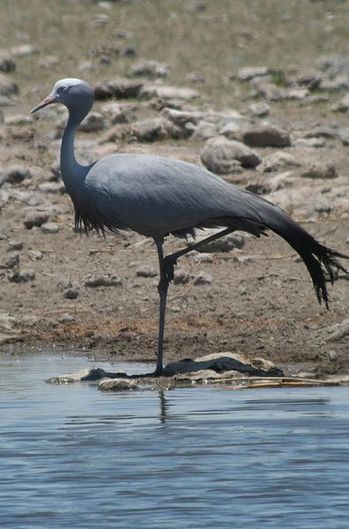
The Blue Crane (Anthropoides paradiseus), also known as the Stanley Crane and the Paradise Crane, is the national bird of South Africa. It is a tall, ground-dwelling bird, but is fairly small by the standards of the crane family. It is 100–120 cm (40–47 in) tall and weighs from 4 to 6.2 kg (8.8-13.6 lbs). This crane is pale blue-gray in colour with a white crown, a pink bill, and long, dark gray wingtip feathers which trail to the ground.
Blue Cranes are birds of the dry, grassy uplands which feed on seeds and insects and spend little time in wetlands. They are altitudinal migrants, generally nesting in the upper grasslands and moving down to lower altitudes for winter. Many occupy agricultural areas.
Of the 15 species of crane, the Blue Crane has the most restricted distribution of all.
Blue Cranes are birds of the dry, grassy uplands which feed on seeds and insects and spend little time in wetlands. They are altitudinal migrants, generally nesting in the upper grasslands and moving down to lower altitudes for winter. Many occupy agricultural areas.
Of the 15 species of crane, the Blue Crane has the most restricted distribution of all.
Common Raven-National Bird Of Bhutan
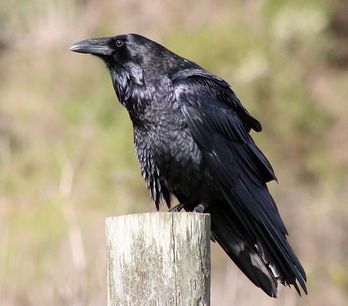
The Common Raven (Corvus corax), also known as the Northern Raven, is a large, all-black passerine bird. Found across the northern hemisphere, it is the most widely distributed of all corvids. There are at least eight subspecies with little variation in appearance although recent research has demonstrated significant genetic differences among populations from various regions. It is one of the two largest corvids, alongside the Thick-billed Raven, and is possibly the heaviest passerine bird; at maturity, the Common Raven averages 63 cm (25 inches) in length and 1.2 kg (2.6 pounds). Common Ravens typically live about 10 to 15 years in the wild, although lifespans of up to 40 years have been recorded. Young birds may travel in flocks, but later mate for life, with each mated pair defending a territory.
The Common Raven has coexisted with humans for thousands of years and in some areas has been so numerous that it is considered a pest. Part of its success comes from its omnivorous diet; Common Ravens are extremely versatile and opportunistic in finding sources of nutrition, feeding on carrion, insects, cereal grains, berries, fruit, small animals, and food waste.
Some remarkable feats of problem-solving have been observed in the species, leading to the belief that it is highly intelligent. Over the centuries, it has been the subject of mythology, folklore, art, and literature. In many indigenous cultures, including those of Scandinavia, ancient Ireland and Wales, Bhutan, the northwest coast of North America, and Siberia and northeast Asia, the Common Raven has been revered as a spiritual figure or god.
The Common Raven has coexisted with humans for thousands of years and in some areas has been so numerous that it is considered a pest. Part of its success comes from its omnivorous diet; Common Ravens are extremely versatile and opportunistic in finding sources of nutrition, feeding on carrion, insects, cereal grains, berries, fruit, small animals, and food waste.
Some remarkable feats of problem-solving have been observed in the species, leading to the belief that it is highly intelligent. Over the centuries, it has been the subject of mythology, folklore, art, and literature. In many indigenous cultures, including those of Scandinavia, ancient Ireland and Wales, Bhutan, the northwest coast of North America, and Siberia and northeast Asia, the Common Raven has been revered as a spiritual figure or god.
European Robin-National Bird Of United Kingdom

The European Robin (Erithacus rubecula), most commonly known in Anglophone Europe simply as the Robin, is a small insectivorous passerine bird that was formerly classed as a member of the thrush family (Turdidae), but is now considered to be an Old World flycatcher (Muscicapidae). Around 12.5–14.0 cm (5.0–5.5 in) in length, the male and female are similar in colouration, with an orange breast and face lined with grey, brown upperparts and a whitish belly. It is found across Europe, east to Western Siberia and south to North Africa; it is sedentary in most of its range except the far north.
The term Robin is also applied to some birds in other families with red or orange breasts. These include the American Robin (Turdus migratorius), which is a thrush, and the Australian red robins of the genus Petroica, members of a family whose relationships are unclear.
The term Robin is also applied to some birds in other families with red or orange breasts. These include the American Robin (Turdus migratorius), which is a thrush, and the Australian red robins of the genus Petroica, members of a family whose relationships are unclear.
Green Pheasant-National Bird Of Japan
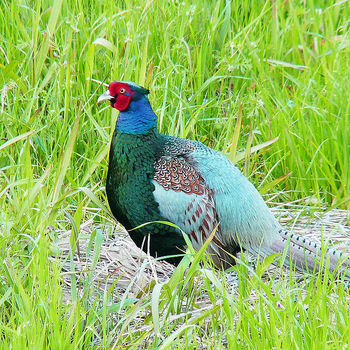
The Green Pheasant, Phasianus versicolor also known as Japanese Pheasant is a bird of the lowlands. Closely related to the Common Pheasant, the cock is distinguished by dark green plumage on breast and mantle. The male has an iridescent violet neck, red bare facial skin and purplish green tail. The female is smaller than male, and has a dull brown plumage with dark spots.
Native and endemic to the Japanese Archipelago, the Green Pheasant is the national bird of Japan.
This species is common and widespread throughout its native range. It frequents farmlands and is often seen close to human settlements; it also has been introduced in Hawaii and the United States as a gamebird.
Some authorities consider the Green Pheasant a subspecies of the Common Pheasant.
Fagiano Okayama football club, a club based in Okayama, Okayama Prefecture, has a mascot based on the Green Pheasant.
Native and endemic to the Japanese Archipelago, the Green Pheasant is the national bird of Japan.
This species is common and widespread throughout its native range. It frequents farmlands and is often seen close to human settlements; it also has been introduced in Hawaii and the United States as a gamebird.
Some authorities consider the Green Pheasant a subspecies of the Common Pheasant.
Fagiano Okayama football club, a club based in Okayama, Okayama Prefecture, has a mascot based on the Green Pheasant.
Himalayan Monal-National Bird Of Nepal
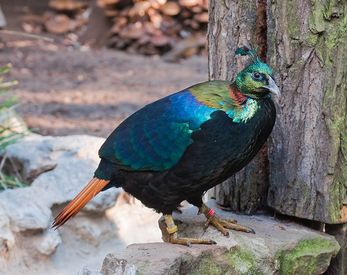
The Himalayan Monal, Lophophorus impejanus also known as the Impeyan Monal or Impeyan Pheasant or Danphe is a bird of genus Lophophorus of the pheasant family, Phasianidae. It is the national bird of Nepal, where it is known as the Danfe, and the state bird of Uttarakhand.
Traditionally, the Himalayan Monal has been classified as monotypic. However, studies have shown that the male Himalayan Monals of northwestern India lack the white rump that other Himalayan Monals have, and have more green on the breast, indicating the possibility of a second subspecies.
The scientific name commemorates Lady Mary Impey, the wife of the British chief justice of Bengal, Sir Elijah Impey.
Traditionally, the Himalayan Monal has been classified as monotypic. However, studies have shown that the male Himalayan Monals of northwestern India lack the white rump that other Himalayan Monals have, and have more green on the breast, indicating the possibility of a second subspecies.
The scientific name commemorates Lady Mary Impey, the wife of the British chief justice of Bengal, Sir Elijah Impey.
Indian Peacock-National Bird Of India

The Asiatic peafowl is a kind of bird. They are the genus Pavo from the Phasianidae family. They originally live in Pakistan and India, Southeast Asia. In Pakistan, it is the provincial/regional bird of the Punjab.
The males are very colorful, and they have very long train feathers (or tail feathers), which they can move up like a fan. Females are less colorful, and do not have the long train-feathers. Both the male and the female have a little "Crown" of feathers on their head. Males show their train feathers to court a female peafowl, or to scare other animals away by making them afraid.
Peafowl are omnivorous and eat plant parts, flower petals, seeds, insects, and small vertebrates, like reptiles and amphibians.
- Genus Pavo
- Blue Peafowl or Indian Peafowl (Pavo cristatus)
- Green Peafowl (Pavo muticus)
The males are very colorful, and they have very long train feathers (or tail feathers), which they can move up like a fan. Females are less colorful, and do not have the long train-feathers. Both the male and the female have a little "Crown" of feathers on their head. Males show their train feathers to court a female peafowl, or to scare other animals away by making them afraid.
Peafowl are omnivorous and eat plant parts, flower petals, seeds, insects, and small vertebrates, like reptiles and amphibians.
Philippine Eagle-National Bird Of Philippines

The Philippine Eagle ( Pithecophaga jefferyi) also known as the Great Philippine Eagle or Monkey-eating Eagle, is among the rarest, largest, and most powerful birds in the world. This bird of prey is endemic to forests in the Philippines, where it is the national bird.It has numerous local names, including Agila, Haribon, Haring Ibon (Which means "Bird King") and banog.Killing this critically endangered species is punishable under Philippine law by twelve years in jail and heavy fines.
Red-crowned Crane-National Bird Of China
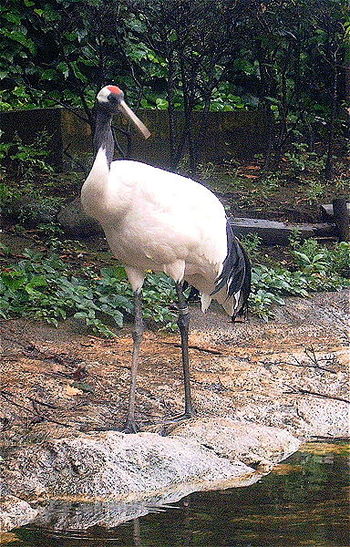
The Red-crowned Crane (Grus japonensis), also called the Japanese Crane or Manchurian Crane, is a large crane and is the second rarest crane in the world. In East Asia, it is known as a symbol of luck and fidelity. At 55 inches high, the crane does not make easy prey, for all that it stands out in its natural habitat of marshes and swamps. When it matures, the Red-crowned Crane is snow white with a patch of red skin on its head.
In the spring and summer, the Red-crowned Crane lives in Siberia, where their eggs hatch. Normally the crane lays 2 eggs, with only one surviving. Later, in the fall, it migrates in flocks to Korea, Japan, China, Taiwan, and other countries in East Asia to spend the winter. All Red-crowned Cranes migrate, except for a flock that stays in Hokkaido, year long.
In the spring and summer, the Red-crowned Crane lives in Siberia, where their eggs hatch. Normally the crane lays 2 eggs, with only one surviving. Later, in the fall, it migrates in flocks to Korea, Japan, China, Taiwan, and other countries in East Asia to spend the winter. All Red-crowned Cranes migrate, except for a flock that stays in Hokkaido, year long.
The Rufous Hornero-National Bird Of Argentina
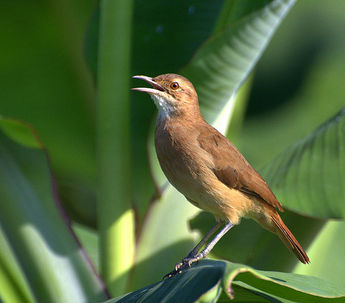
The Rufous Hornero, Furnarius rufus, is a large ovenbird from eastern South America. Also known as the Red Ovenbird, it is a common species of second-growth scrub, pastures and agricultural land, and the species is often seen near areas of human inhabitation. Its range includes south eastern and southern Brazil, Bolivia, Paraguay, Uruguay and northern and central Argentina (Down to northern Patagonia). The species is most closely related to the Crested Hornero of Paraguay and Argentina. There are four accepted subspecies.
It builds its nests on high places such as telephone poles, or trees. When it makes a nest, it looks like a cup that has fallen over to the side, or like an old-fashioned baker's oven. To make it, the Rufous Hornero mixes grass and animal hair and mud, and then leaves it to dry. Inside there is a grassy room where it lays its eggs.
It builds its nests on high places such as telephone poles, or trees. When it makes a nest, it looks like a cup that has fallen over to the side, or like an old-fashioned baker's oven. To make it, the Rufous Hornero mixes grass and animal hair and mud, and then leaves it to dry. Inside there is a grassy room where it lays its eggs.
Rufous-bellied Thrush-National Bird Of Brazil
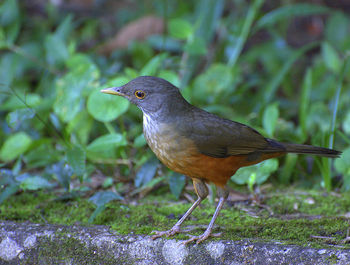
The Rufous-bellied Thrush (Turdus rufiventris) is a songbird of the thrush family (Turdidae). It occurs in most of east and southeast Brazil from Maranhão south to Rio Grande do Sul states, Bolivia, Paraguay, Uruguay and northern regions of Argentina.It is one of the most common birds across much of southeastern Brazil, and is well-known there under its local name sabiá-laranjeira. The Rufous-bellied Thrush has been the state bird of São Paulo since 1966. It was proposed as the national bird of Brazil, and was officially chosen in 2002.
This species is named after its distinctive reddish-orange underparts. Rufous-bellied Thrushes can reach a length of 25 cm and weigh up to 68 g (male) or 78 g (female), though weights of about 59 g for males and 64 g for females are more usual. Contrary to what one might expect from the rather marked weight difference, the females are not larger, only plumper; their tarsus is actually a bit shorter than that of males on average.
This species is named after its distinctive reddish-orange underparts. Rufous-bellied Thrushes can reach a length of 25 cm and weigh up to 68 g (male) or 78 g (female), though weights of about 59 g for males and 64 g for females are more usual. Contrary to what one might expect from the rather marked weight difference, the females are not larger, only plumper; their tarsus is actually a bit shorter than that of males on average.
Sri Lankan Junglefowl-National Bird Of Sri Lanka
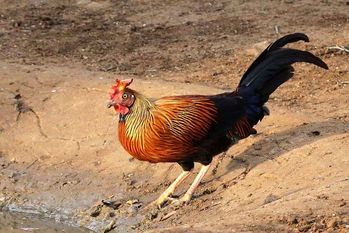
The Sri Lankan Junglefowl (Gallus lafayetii), also known during the colonial era as the Ceylon Junglefowl, is a member of the pheasant family which is endemic to Sri Lanka, where it is the national bird. It is closely related to the Red Junglefowl (G. gallus), the wild junglefowl from which the chicken was domesticated. The specific name of the Sri Lankan Junglefowl commemorates the French aristocrat Gilbert du Motier, marquis de La Fayette.
As with other junglefowl, the Sri Lankan Junglefowl is strongly sexually dimorphic: the male is much larger than the female, with more vivid plumage and a highly exaggerated wattle and comb.
The male Sri Lankan Junglefowl ranges from 66–73 cm long, essentially resembling a large, muscular rooster. The male has orange-red body plumage, and dark purple to black wings and tail. The feathers of the mane descending from head to base of spine are golden, and the face has bare red skin and wattles. The comb is red with a yellow centre. As with the Green Junglefowl, the cock does not possess an eclipse plumage.
The female is much smaller, at only 35 cm, with dull brown plumage with white patterning on the lower belly and breast, ideal camouflage for a nesting bird.
As with other junglefowl, the Sri Lankan Junglefowl is strongly sexually dimorphic: the male is much larger than the female, with more vivid plumage and a highly exaggerated wattle and comb.
The male Sri Lankan Junglefowl ranges from 66–73 cm long, essentially resembling a large, muscular rooster. The male has orange-red body plumage, and dark purple to black wings and tail. The feathers of the mane descending from head to base of spine are golden, and the face has bare red skin and wattles. The comb is red with a yellow centre. As with the Green Junglefowl, the cock does not possess an eclipse plumage.
The female is much smaller, at only 35 cm, with dull brown plumage with white patterning on the lower belly and breast, ideal camouflage for a nesting bird.
Troupial-National Bird Of Venezuela
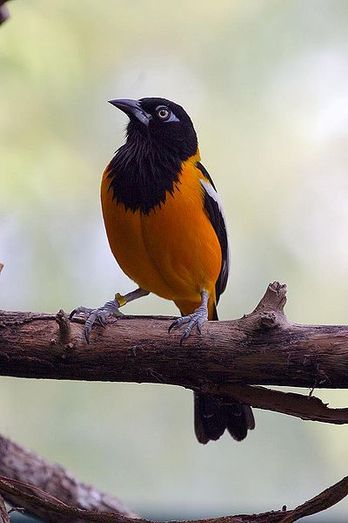
The Troupial (Turpial in Spanish), Icterus icterus is the national bird of Venezuela and one of about 25 or so species of "New World Orioles". It is found across South America east of the Andes, from Colombia, Venezuela and the Guianas down to Argentina. This bird can also found on Aruba, Bonaire and Curaçao.
The Troupial is fairly large in size, with a long tail and a bulky bill. It has a black head and upper breast. The feathers on the front of the neck and upper breast stick outward, making an uneven boundary between the black and the orange of the bird's lower breast and underside. The rest of the orange color is found on the upper and lower back, separated by the black shoulders. The wings are mostly black except for a white streak that runs the length of the wing when in a closed position. The eyes are yellow, and surrounding each one, there is a patch of bright, blue, naked skin.
Troupials inhabit dry areas like woodlands, gallery forest, dry scrub, llanos and open savannah where they forage for insects, a wide variety of fruit, small birds and eggs. Generally they can be found in central South America with some of the subspecies to the northern and eastern extremes of the continent.
The Troupial is fairly large in size, with a long tail and a bulky bill. It has a black head and upper breast. The feathers on the front of the neck and upper breast stick outward, making an uneven boundary between the black and the orange of the bird's lower breast and underside. The rest of the orange color is found on the upper and lower back, separated by the black shoulders. The wings are mostly black except for a white streak that runs the length of the wing when in a closed position. The eyes are yellow, and surrounding each one, there is a patch of bright, blue, naked skin.
Troupials inhabit dry areas like woodlands, gallery forest, dry scrub, llanos and open savannah where they forage for insects, a wide variety of fruit, small birds and eggs. Generally they can be found in central South America with some of the subspecies to the northern and eastern extremes of the continent.
The Oriental Magpie Robin -National Bird Of Bangladesh
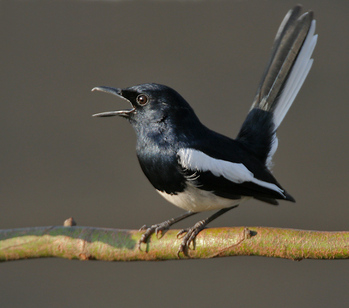
The Oriental Magpie Robin (Copsychus saularis) is a small passerine bird that was formerly classed as a member of the thrush family Turdidae, but now considered an Old World flycatcher. They are distinctive black and white birds with a long tail that is held upright as they forage on the ground or perch conspicuously. Distributed in many parts of tropical South and Southeast Asia, they are common birds in urban gardens as well as forests. They are particularly well known for their songs and were once popular as cagebirds.
This species is 19 centimetres (7.5 in) long, including the long tail that is usually held cocked upright. It is similar in shape to the smaller European Robin, but is longer-tailed. The male has black upperparts, head and throat apart from a white shoulder patch. The underparts and the sides of the long tail are white. Females are greyish black above and greyish white. Young birds have scaly brown upperparts and head.
This species is 19 centimetres (7.5 in) long, including the long tail that is usually held cocked upright. It is similar in shape to the smaller European Robin, but is longer-tailed. The male has black upperparts, head and throat apart from a white shoulder patch. The underparts and the sides of the long tail are white. Females are greyish black above and greyish white. Young birds have scaly brown upperparts and head.

